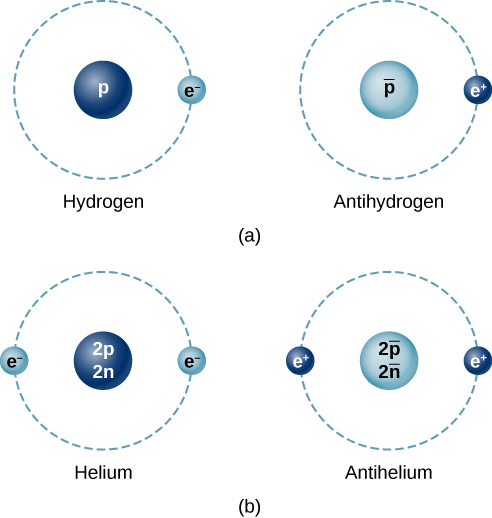| << Chapter < Page | Chapter >> Page > |
Soon it was discovered that for every particle in nature, there is a corresponding antiparticle . An antiparticle has the same mass and lifetime as its associated particle, and the opposite sign of electric charge. These particles are produced in high-energy reactions. Examples of high-energy particles include the antimuon ( ), anti-up quark ( ), and anti-down quark (Note that antiparticles for quarks are designated with an over-bar.) Many mesons and baryons contain antiparticles. For example, the antiproton ( ) is and the positively charged pion is . Some neutral particles, such as the photon and the meson, are their own antiparticles. Sample particles, antiparticles, and their properties are listed in [link] .
| Particle name | Symbol | Antiparticle | Mass | Average lifetime (s) | |
|---|---|---|---|---|---|
| Leptons | |||||
| Electron | 0.511 | Stable | |||
| Electron neutrino | Stable | ||||
| Muon | 105.7 | ||||
| Muon neutrino | Stable | ||||
| Tau | 1784 | ||||
| Tau neutrino | Stable | ||||
| Hadrons | |||||
| Baryons | Proton | p | 938.3 | Stable | |
| Neutron | n | 939.6 | 920 | ||
| Lambda | 1115.6 | ||||
| Sigma | 1189.4 | ||||
| Xi | 1315 | ||||
| Omega | 1672 | ||||
| Mesons | Pion | 139.6 | |||
| -Zero | 135.0 | ||||
| Kaon | 493.7 | ||||
| k -Short | 497.7 | ||||
| k -Long | 497.0 | ||||
| J / | J / | J / | 3100 | ||
| Upsilon | 9460 |
The same forces that hold ordinary matter together also hold antimatter together. Under the right conditions, it is possible to create antiatoms such as antihydrogen, antioxygen, and even antiwater. In antiatoms, positrons orbit a negatively charged nucleus of antiprotons and antineutrons. [link] compares atoms and antiatoms.

Antimatter cannot exist for long in nature because particles and antiparticles annihilate each other to produce high-energy radiation. A common example is electron-positron annihilation. This process proceeds by the reaction
The electron and positron vanish completely and two photons are produced in their place. (It turns out that the production of a single photon would violate conservation of energy and momentum.) This reaction can also proceed in the reverse direction: Two photons can annihilate each other to produce an electron and positron pair. Or, a single photon can produce an electron-positron pair in the field of a nucleus, a process called pair production. Reactions of this kind are measured routinely in modern particle detectors. The existence of antiparticles in nature is not science fiction.
Watch this video to learn more about matter and antimatter particles.
What are the four fundamental forces? Briefly describe them.
Strong nuclear force: interaction between quarks, mediated by gluons. Electromagnetic force: interaction between charge particles, mediated photons. Weak nuclear force: interactions between fermions, mediated by heavy bosons. Gravitational force: interactions between material (massive) particle, mediate by hypothetical gravitons.
Distinguish fermions and bosons using the concepts of indistiguishability and exchange symmetry.
List the quark and lepton families
electron, muon, tau; electron neutrino, muon neutrino, tau neutrino; down quark, strange quark, bottom quark; up quark, charm quark, top quark
Distinguish between elementary particles and antiparticles. Describe their interactions.
How much energy is released when an electron and a positron at rest annihilate each other? (For particle masses, see [link] .)
1.022 MeV
If of energy is released in the annihilation of a sphere of matter and antimatter, and the spheres are equal mass, what are the masses of the spheres?
When both an electron and a positron are at rest, they can annihilate each other according to the reaction
In this case, what are the energy, momentum, and frequency of each photon?
0.511 MeV, ,
What is the
total kinetic energy carried away by the particles of the following decays?

Notification Switch
Would you like to follow the 'University physics volume 3' conversation and receive update notifications?